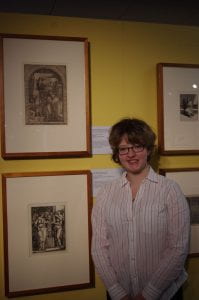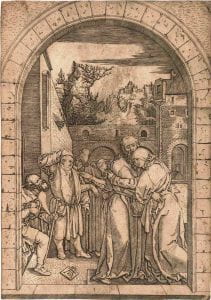Horizon Lines: Copyright Infringement and Collaboration
The Baillieu Print Collection contains over 9,000 works of art including pieces by Rembrandt, Dürer and the Australian artist, Lionel Lindsay. Some of the highlights of the collection are shown in the newly opened exhibition Horizon Lines: The Ambitions of a Print Collection. Having visited the exhibition, I can thoroughly recommend it and thought I would share some of my thoughts.
The exhibition is being held to celebrate the 50th anniversary of the Harold Wright and Sarah & William Holmes scholarships, which sponsor Australian and New Zealand scholars to go to the British Museum to study the print collection. The scholarships aim to promote collaboration between institutions in Britain and Australia and New Zealand. Notably, this latest exhibition features several replicas and drawings of objects from the British Museum collections.

Harold Wright (1885-1961) was a print dealer and collector who exercised significant influence in the print world. Working at the art dealership P&D Colnaghi in London, he guided print artists about the work that they should create in relation to trends in the art market. He also advised print collectors regarding the works of art they should acquire. Additionally, he also played an important role in the Baillieu Print Collection – the donation in 1964, which included works by the Australian artist Lionel Lindsay and his British contemporaries, greatly increased the holdings of the collection. It is Wright’s passion for the development of print that has inspired the exhibition. It examines the work of the Northern and Italian Renaissance printmakers during the sixteenth and seventeenth centuries and works created during the etching revival of the nineteenth and twentieth centuries.
One story contained within the exhibition that particularly interested me is that of Marcantonio Raimondi (1480-1534). The only print-maker/engraver about whom Giorgio Vasari devoted an entire volume in his series of volumes Lives about the lives of famous artists. In part, this was due to his significance as the first print-maker to use the medium to create copies of artworks.
This was not without its controversy however, and some of Marcantonio’s early works led to conflict between Marcantonio and the German painter, printmaker and theorist, Dürer. In 1506, Dürer complained to the Venetian Senate that Marcantonio had been selling copies of his Life of the Virgin series as originals (Marcantonio even had the audacity to copy Dürer’s signature). This may have been one of the first copyright and intellectual property disputes. The exhibition features one of these copies of Dürer’s work, Joachim and St Anne Meeting at the Golden Gate, which was donated by Dr J. Orde Poynton.

Despite this setback, Marcantonio went on to make a good living out of producing copies of famous paintings, drawings and engravings. He collaborated for many years with the Italian Renaissance artist, Raphael, who recognised that by allowing print copies of his work to be made, he was making his images more accessible to a wider audience, boosting his renown. Raimondi’s “copies” of works by Raphael showed some elements of originality – his prints were taken from sketches made during the creation of the work, not necessarily from the end product. Their collaboration is often cited as influential in making Raphael one of the most famous Italian Renaissance artists and the exhibition highlights the importance of print in making art accessible to the masses.
Erin Holder, International Museums and Collections (IMAC) award recipient.
Placement Blog: Behind the Display Case
References
Baillieu Print Collection – Baillieu Print Collection
Ehrenfest, F., ‘Marcantonio Raimondi’, Bulletin of the City Art Museum of St. Louis, Vol 34: No 2, (1949), pp. 59-62.
Hind, A., Raimondi and Italian Engravers and Etchers of the Sixteenth Century (New York, 1912).
Pon, L., Raphael, Dürer and Marcantonio Raimondi: Copying and the Italian Renaissance Print (Yale, 2004).
Wouk, E.H., Marcantonio Raimondi, Raphael and the Image Multiplied (Manchester, 2016).
Leave a Reply